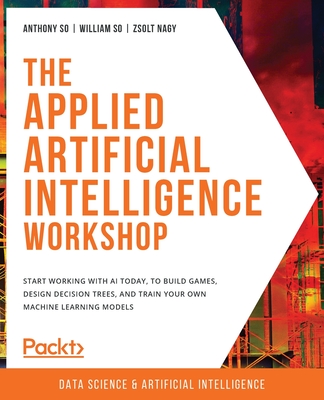Artificial Intelligence for Robotics - Second Edition: Build intelligent robots using ROS 2, Python, OpenCV, and AI/ML techniques for real-world tasks
, Francis X. Govers, III
- 出版商: Packt Publishing
- 出版日期: 2024-03-29
- 售價: $1,890
- 貴賓價: 9.5 折 $1,796
- 語言: 英文
- 頁數: 344
- 裝訂: Quality Paper - also called trade paper
- ISBN: 1805129597
- ISBN-13: 9781805129592
-
相關分類:
影像辨識 Image-recognition、Python、程式語言、人工智慧、機器人製作 Robots
立即出貨 (庫存=1)
相關主題
商品描述
Learn how to apply artificial intelligence, engineering, and machine learning to create smart robots capable of interacting with their environment, engaging with users, making decisions, and navigating autonomously
Key Features:
- Gain a holistic understanding of robot design, systems engineering, and task analysis
- Implement AI/ML techniques to detect and manipulate objects and navigate robots using landmarks
- Integrate voice and natural language interactions to create a digital assistant and artificial personality for your robot
- Purchase of the print or Kindle book includes a free PDF eBook
Book Description:
Unlock the potential of your robots by enhancing their perception with cutting-edge artificial intelligence and machine learning techniques. From neural networks to computer vision, this book equips you with the tools and practical use cases to create truly smart robots.
Starting with robotics basics, robot architecture, control systems, and decision-making theory, this book presents systems-engineering methods to design problem-solving robots with single-board computers. You'll explore object recognition and genetic algorithms to teach your robot to identify and pick up objects, and you'll also harness the power of natural language processing to give your robot a voice. To enhance your robot further, you'll master neural networks to classify and separate objects and navigate autonomously, before advancing to guiding your robot arms using reinforcement learning and genetic algorithms. The book also covers path planning and goal-oriented programming to prioritize your robot's tasks, showing you how to connect all software using Python and ROS 2 for a seamless experience.
By the end of this book, you'll have learned how to transform your robot into a helpful assistant with NLP and give it an artificial personality, ready to tackle real-world tasks and even crack jokes.
What You Will Learn:
- Get started with robotics and AI essentials
- Understand path planning, decision trees, and search algorithms to enhance your robot
- Explore object recognition using neural networks and supervised learning techniques
- Employ genetic algorithms to enable your robot arm to manipulate objects
- Teach your robot to listen using Natural Language Processing through an expert system
- Program your robot in how to avoid obstacles and retrieve objects with machine learning and computer vision
- Apply simulation techniques to give your robot an artificial personality
Who this book is for:
This book is for practicing robotics engineers and enthusiasts aiming to advance their skills by applying AI and ML techniques. Students and researchers looking for practical guidance for solving specific problems or approaching a difficult robot design will find this book insightful.
Proficiency in Python programming, familiarity with electronics and wiring, single board computers, Linux-based command-line interface (CLI), and knowledge of AI/ML concepts are required to get started with this book.
商品描述(中文翻譯)
學習如何應用人工智慧、工程學和機器學習,創造出能夠與環境互動、與使用者互動、做出決策並自主導航的智能機器人。
主要特點:
- 獲得機器人設計、系統工程和任務分析的整體理解
- 使用人工智慧/機器學習技術來檢測和操作物體,並使用地標導航機器人
- 整合語音和自然語言互動,為您的機器人創建數字助手和人工智能個性
- 購買印刷版或Kindle電子書,可獲得免費PDF電子書
書籍描述:
通過運用尖端的人工智慧和機器學習技術,提升您的機器人的感知能力,發揮其潛力。從神經網絡到計算機視覺,本書為您提供了工具和實際應用案例,創建真正智能的機器人。
從機器人基礎知識、機器人架構、控制系統和決策理論開始,本書介紹了系統工程方法,設計單板計算機的問題解決機器人。您將探索物體識別和遺傳算法,教導您的機器人識別和拾取物體,並利用自然語言處理的力量賦予您的機器人語音。為了進一步提升您的機器人,您將掌握神經網絡,對物體進行分類和分離,並實現自主導航,然後通過強化學習和遺傳算法引導您的機器人手臂。本書還涵蓋了路徑規劃和目標導向編程,以優先處理您的機器人任務,並展示如何使用Python和ROS 2連接所有軟件,實現無縫體驗。
通過閱讀本書,您將學習如何通過NLP將您的機器人轉變為一個有用的助手,並賦予它人工智能個性,準備應對現實世界的任務,甚至開玩笑。
您將學到什麼:
- 入門機器人和人工智慧基礎知識
- 理解路徑規劃、決策樹和搜索算法,以提升您的機器人
- 探索使用神經網絡和監督學習技術進行物體識別
- 使用遺傳算法使您的機器人手臂能夠操作物體
- 通過專家系統使用自然語言處理教導您的機器人聆聽
- 使用機器學習和計算機視覺,編程您的機器人避開障礙物並檢索物體
- 應用模擬技術賦予您的機器人人工智能個性
本書適合專業機器人工程師和愛好者,他們希望通過應用人工智慧和機器學習技術來提升自己的技能。學生和研究人員尋求解決特定問題或解決困難機器人設計的實際指導,也會發現本書富有洞察力。
開始閱讀本書需要具備以下技能:Python編程能力,熟悉電子學和連接線,單板計算機,基於Linux的命令行界面(CLI),以及對人工智慧/機器學習概念的了解。











